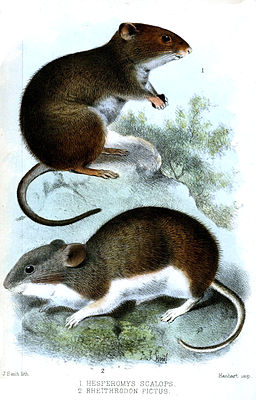Large long-clawed mice
| Large long-clawed mice | ||||||||||||
|---|---|---|---|---|---|---|---|---|---|---|---|---|

Chelemys megalonyx scalops (top picture) |
||||||||||||
| Systematics | ||||||||||||
|
||||||||||||
| Scientific name | ||||||||||||
| Chelemys | ||||||||||||
| Thomas , 1903 |
The large long-clawed mice ( Chelemys ) are a species of rodent living in South America from the group of the New World mice . It is of three types.
Large long-clawed mice are New World mice adapted to a burrowing way of life. They reach a head-trunk length of 11 to 15 centimeters, the tail is relatively short at around 5 centimeters. The weight is 50 to 100 grams. The fur is short, very dense and uniformly gray in color. The claws of the front paws are long and strong, the claws of the rear paws are slightly shorter. The ears are small but visible.
These animals live in southern South America in central and southern Chile and Argentina . They predominantly inhabit forests, for example with false beeches . They sometimes live digging, but can also be found on the surface. They go in search of food both day and night. Their diet consists of insects, green parts of plants, mushrooms and tubers.
There are three types:
- Chelemys delfini lives in the Magallanes region in the extreme south of Chile. Their taxonomic status is controversial.
- Chelemys macronyx lives in the southern Andes on the Chilean-Argentine border from the 34th southern parallel to the Strait of Magellan .
- Chelemys megalonyx is native to the coastal region of central Chile.
None of the species is endangered according to the IUCN .
literature
- Ronald M. Nowak: Walker's Mammals of the World. 2 volumes. 6th edition. Johns Hopkins University Press, Baltimore MD et al. 1999, ISBN 0-8018-5789-9 .
- Don E. Wilson , DeeAnn M. Reeder (Eds.): Mammal Species of the World. A taxonomic and geographic Reference. 2 volumes. 3. Edition. Johns Hopkins University Press, Baltimore MD 2005, ISBN 0-8018-8221-4 .
Web links
- Endangerment level of the individual species in the IUCN Red List of Threatened Species .